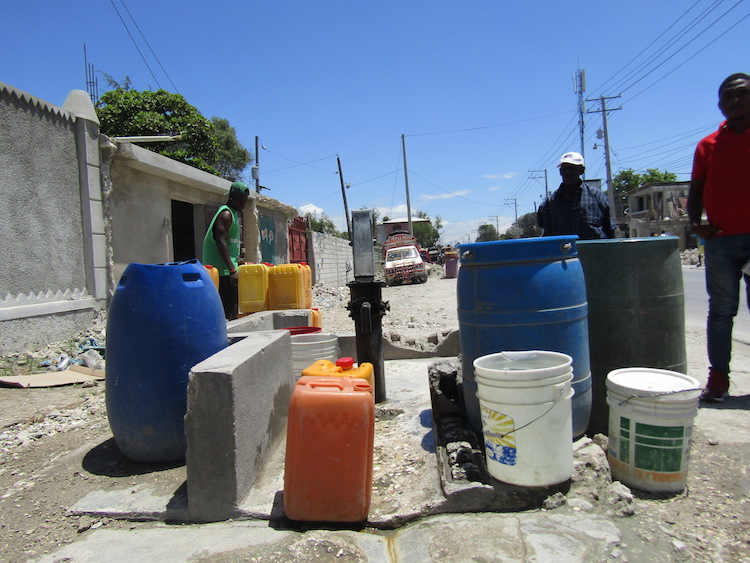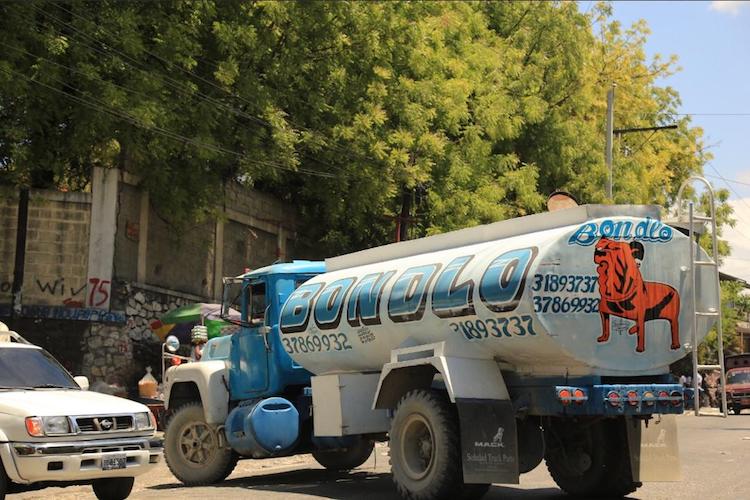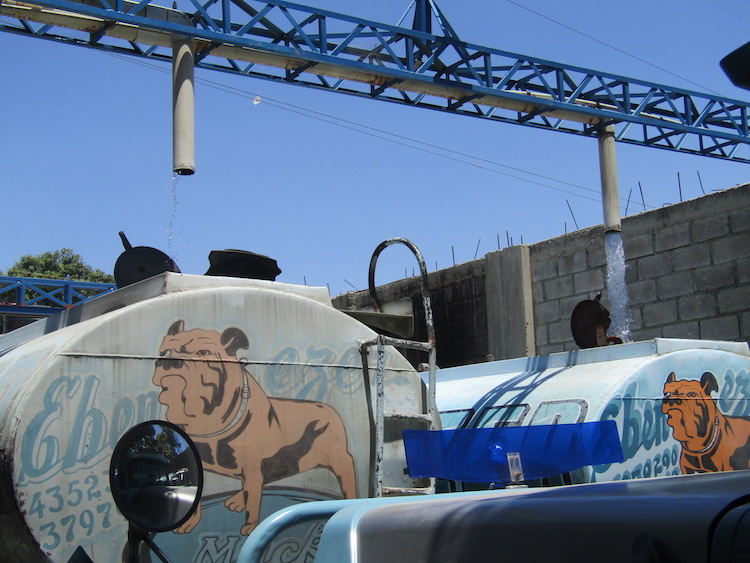While the State does nothing to solve access to drinking water for more than 1.5 million Haitians in the metropolitan area of Port-au-Prince, private companies extract water from the main aquifer that supplies the region free of charge and uncontrollably. It’s water that does not pass through quality controls and is then sold to citizens at an inaccessible cost to many.
This main source of drinking water, Cul-de-Sac, is contaminated.
In Haiti, misgovernment, the lack of economic resources and abuse by companies come together in a fatal combination for a large part of the population that — for the most part lacks sanitary services or drinking water — becomes part of the vicious cycle of exploitation of the resource at a time when climate change extends the drought periods in the Caribbean, a joint investigation by the Center for Investigative Journalism and Le Nouvelliste revealed.
The number of those lacking access to drinking water in the entire country is almost 6 million, which represents more than 40% of the population.

Photo by Ralph Pradeus | Le Nouvelliste
People filling water in buckets in public water fountain
The aquifer that extends under the Cul-de-Sac plain in southeastern Haiti is the largest source of water supply for both community consumption, industrial and agricultural use in the metropolitan area of the Haitian capital. The National Directorate of Drinking Water and Sanitation (DINEPA for its initials in French) — the Haitian government agency responsible for drinking water — manages 18 wells in this region to serve the metropolitan area that daily requires 300,000 cubic meters of water. Despite this, it extracts only 37% of the city’s need (110,000 cubic meters.)
Private companies extract water illegally in that zone with no extraction permits, the investigation revealed. In turn, authorities acknowledged they do not keep track of the amount of water they collect daily. At press time, they had not even provided the names of the companies that have registered for legal extraction.
“The Haitian State has no control over this activity. Brewers, water purification companies, and others in the region collect water without the supervision of the authorities,” Astrel Joseph, director of Water Resources of the Ministry of Environment, acknowledged in an interview.
His ministry is also legally responsible for much of the management of water resources, including the regulation of water quality and the development of public policies. However, the agency has been unstable, with 15 changes in ministers since its creation in 1994. In a period of five years, between 2011 and 2016, there were four ministers. During the presidency of Moïse, which began in 2017, there have already been two.
Addressed on the findings, both the Minister of Agriculture, Natural Resources and Rural Development, Jobert Angrand, and the director of Water Resources of the Ministry of Environment, Astrel Joseph, recognized the deficiencies of their administrations in the preservation of water.
“Water Service, for example, has not granted any authorizations to drill wells in the Cul-de-Sac plain over the last 20 years. However, the number of wells drilled is increasing,” Angrand accepted.
Meanwhile, the Ministry of Agriculture also maintains almost exclusive authority over irrigation and water management for agriculture and has recently also attempted to expand its powers to include watershed management.
DINEPA is responsible for the country’s water, sanitation, and hygiene. Before the DINEPA was established in 2009, there was no explicit water regulator, and the Ministry of Health assumed that role.
DINEPA’s public policy is that it is necessary to pay for the service since it must be sustainable despite the fact that formal clients are the minority of the population in urban areas.
In the absence of an efficient supply by the State, many people resort to buying water. It is extracted from aquifers and stored in tankers or sold bottled. Although not a new practice, after the 2010 earthquake destroyed the city’s infrastructure almost entirely, this mode of distribution reached unprecedented proportions. The use of bottled water increased from 9% in 2006 to 47% in 2017, according to data from the Haiti Mortality and Morbidity Survey.
According to the World Bank’s macroeconomic data on poverty in Haiti, more than 60% of the poor live on less than $2 USD per day. Water is very expensive since the sales prices vary according to the neighborhood and the area, ranging from 1500 gourdes (around $18 USD) to 4000 gourdes (around $48 USD.)
This business, in addition to being lucrative, does not declare taxes nor does it control the quality of the water sold.
The Ministry of Commerce’s Communication Office said, in principle, all companies in the country have to register, although its director, Carlin Michel, acknowledged that not all companies that sell water in tanks are registered.
There are companies that extract water from the Cul-de-Sac aquifer without permission. Not much is known about them, but the ministry recognizes that they exist and that they extract water from the aquifer.
“Anyone can join the water business by truck. Provided of course they have a truck at their disposal,” said a tanker truck driver who spoke on the condition of anonymity.
Being a water truck driver means some don’t have a set schedule of work hours — since they operate all the time, every day — although our interviewee acknowledged that “they are free to set their hours according to their availability.” They can have five to six deliveries per day at peak traffic hours, and 10 in days of high demand. This implies working until dawn, which is possible because the plant is open “24 hours a day.”
Guito Edouard, National Director of DINEPA, did not answer questions about the number of wells and businesses in Cul-de-Sac or on regulations and control measures, or DINEPA’s role within the sector.

Photo by Ralph Pradeus | Le Nouvelliste
People filling water in buckets in public water fountain
The real threat of pollution
Meanwhile, both in Port-au-Prince as in the rest of the country, water quality remains a problem due to polllution by human and animal excrement. The most recent study available, conducted between 2014 and 2015, showed that 68% of the 300 water resources that were tested were polluted. In the case of wells and groundwater, only 3% present health risks.
However, for the majority of the population living in extreme poverty, buying water is not an option due to the lack of accessibility and costs. The risk of fecal contamination remains extremely important due to lack of sanitation, inadequate hygiene practices and environmental degradation. According to Edwidge Petit, director of DINEPA’s sanitation subsector, more than 2 million people do not have access to toilets in their homes and 3 million defecate outside.
To this is compounded to the fact that regulation in the area of sanitation is very recent.
DINEPA’s Directorate of Sanitation was created in 2011 and has a strategic plan through 2030. The challenges that lie ahead are enormous: develop an infrastructure that offers a reliable sanitation service; implement educational campaigns to eliminate the dumping of wastewater by citizens; and enforce the new regulations. This last point requires the surveillance of the more than 140 municipalities and 600 communal sectors throughout the country.
The Cul-de-Sac reserve is already in danger because pollutants have reached the first level of groundwater. It is already necessary to drill more than 120 feet to find usable water.
This type of contamination is coupled with the salinization caused by an excess of water extraction in the area. The danger of saltwater intrusion is imminent as a result of the increase in pumping, a drop in groundwater pressure and the location of the aquifer relative to the sea level, said Edmond Magny, professor of economic geography at the Faculty of Agronomy and Veterinary Medicine and former member of the Cabinet of the Minister of Agriculture from 2004-2006. Félix Rody, doctor in hydrology and environment, agrees.
At present, the exact number of pumping stations is unknown, which prevents setting controls on the extraction of Cul-de-Sac water.
Diverse industries and commercial wells (places where tankers are supplied with water) extract groundwater from this region. The Ministry of Commerce was asked to list the dealers authorized to extract groundwater, but he did not provide the names.
In addition to Cul-de-Sac, the five largest hydrographic basins in Haiti are not adequately protected by the State either, Joseph admitted, who attributed the problem to the lack of human resources.
Haiti has 30 State-owned aquifer basins. However, a 1990 hydrogeological map remains the only reference to Haiti’s water sources.
But, problems are not just related to extraction, they include the distribution of the vital product. The country still does not have national laws on the quality of drinking water, with each operator being responsible for quality monitoring. According to a 2016 study, the Directorate of Quality Control and Consumer Protection (DCCPC) of the Ministry of Commerce and Industry intensified its control activities on the quality of bottled water in the metropolitan area since 2012.
Since most of these companies are not registered in the Ministry of Commerce and Industry, finding them has not been easy. The lack of a legal framework to address some of the sector’s problems is also an aggravating factor. Identifying the company is often done through the collection of bags and bottles in the streets and supermarkets, and through the signs on tanker trucks.
Many of the monitored companies showed acceptable hygiene conditions, although most do not conduct any bacteriological analysis in the water sold or demonstrate that they are tested regularly. In some companies, while disinfection components (ultraviolet and ozone) are installed in water treatment systems, they are out of order. On the other hand, the report regrets the poor conditions of water treatment and supply systems of some companies, despite the numerous recommendations done by inspectors.
The lack of relevant information and scientific research is another major problem that threatens water. For Dr. Evens Emmanuel, researcher on issues of access to water and vice chancellor of the University of Quisqueya, “one of the most important oddities in the dynamics of water in Haiti is the shortage of qualified human resources.”
Asked about the future of water within this context, Emmanuel said “if there is not sufficient investment based on technical work, research and information made available, undoubtedly — and as it is today — the population would face many difficulties to get water.”
In the coming years, due to the increase in the population, the situation could generate severe social conflicts, warned Emmanuel.
“We are moving with considerable speed toward a situation that is perhaps irreversible because the seriousness of the situation will require a level of financing to which Haiti’s socioeconomic status will never be able to reach.”
Lourdes Álvarez and Omaya Sosa Pascual contributed to this story.
Próximo en la serie
2 / 3
¡APOYA AL CENTRO DE PERIODISMO INVESTIGATIVO!
Necesitamos tu apoyo para seguir haciendo y ampliando nuestro trabajo.






